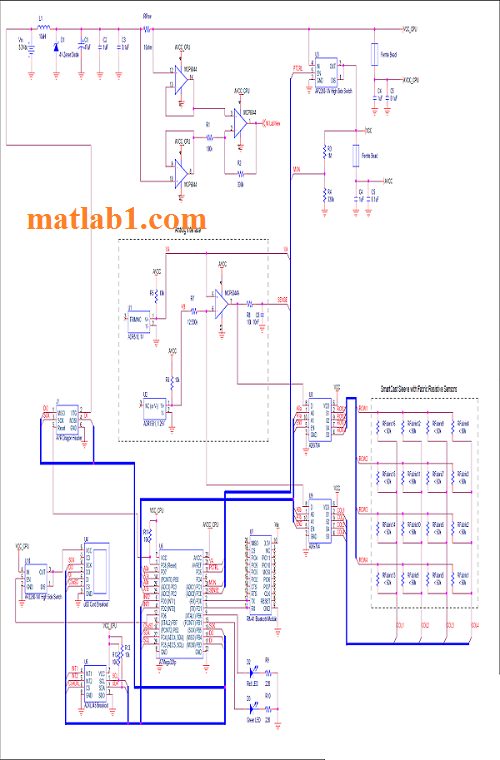Description
A sensor sleeve has been designed that allows the pressure applied by an orthopedic cast to be measured. A number of experiments were carried out to determine the most appropriate textile sensor for this application. Out of all the types of sensors tested, two layers of Velostat with a top and bottom layer of nylon had the least variability between sensors with a suitable resistance range. Individual sensors can be constructed separately and then sewn onto a spandex-nylon sleeve to ease the manufacturing process. The output of these sensors cannot be compared directly as they give an indication of the relative, not absolute, force being applied.
The original SmartCast sensor matrix contained a number of additional paths through the network which confounded the resistance measurements. In order to develop an appropriate solution, the sensor network in [15] was examined and compared to the sensor network used in SmartCast. While the analog interface used in [15] is different than that used in the SmartCast system, a similar solution was used in SmartCast to weaken the effect of the multiple paths, namely tying the unused rows to the 1V reference.
The SmartCast system firmware has been developed and verified . This code was used to obtain all the sensor measurement data presented in this thesis. Furthermore, the firmware has been designed to extend the system lifetime, namely by using the sleep mode of the microcontroller, cutting power to the external SDCard and by using the internal Flash and EEPROM memory of the microcontroller.

SmartCast Circuit Schematic
This code has a document (137 pages) which describe the algorithm in detail.
References
[1] Atmel. “ATmega328p Datasheet.” Atmel.com, Feb. 2013. Web. <http://www.atmel.com/Images/Atmel-8271-8-bit-AVR-Microcontroller-
ATmega48A-48PA-88A-88PA-168A-168PA-328-328P_datasheet.pdf>.
[2] “AVR Libc.” AVR Libc. Savannah.nongnu.org, 3 Jan. 2012. Web. <http://www.nongnu.org/avr-libc/user-manual/index.html>.
[3] Brady, S. et al. “The Development and Characterisation of Conducting Polymericbased Sensing Devices.” Synthetic Metals 154.1-3 (2005): 25-28. ScienceDirect. Web. <http://www.sciencedirect.com/science/article/pii/S0379677905004613#>.
[4] Buechley, Leah. “LilyPad Arduino: How an Open Source Hardware Kit Is Sparking New Engineering and Design Communities.” Web.
<http://citeseerx.ist.psu.edu/viewdoc/summary?doi=10.1.1.168.5521>.
[5] Carpi, F., and D. De Rossi. “Electroactive Polymer-Based Devices for E-Textiles in Biomedicine.” Information Technology in Biomedicine, IEEE Transactions on 9.3 (2005): 295-318. IEEEXplore. Web. <http://ieeexplore.ieee.org/xpls/abs_all.jsp?arnumber=1504800>.
[6] Cook, John D. “Accurately Computing Running Variance.” John D. Cook, n.d. Web. 1 May 2013. <www.johndcook.com>.
[7] Dunne, L., S. Brady, B. Smyth, and D. Diamond. “Initial Development and Testing of A Novel Foam-Based Pressure Sensor for Wearable Sensing.” Journal of Neuroengineering and Rehabilitation (2005): NCBI. Web. <http://www.ncbi.nlm.nih.gov/pmc/articles/PMC554000/>.
[8] Fraden, Jacob. Handbook of Modern Sensors: Physics, Designs, and Applications. 3rd ed. New York: Springer, 2004. Print
[9] Mattmann, C., Amft, O., Harms, H., Troster, G., Clemens, F. “Recognizing Upper Body Postures using Textile Strain Sensors,” Wearable Computers, 2007 11th IEEE International Symposium on , vol., no., pp.29,36, 11-13 Oct. 2007 <http://ieeexplore.ieee.org/xpls/abs_all.jsp?arnumber=4373773>.
[10] Merritt, C., T. Nagle, and E. Grant. “Textile-Based Capacitive Sensors for Respiration Monitoring.” IEEE Sensors Journal 9.1 (2009): 71-78. IEEEXplore. Web. <http://ieeexplore.ieee.org/xpls/abs_all.jsp?arnumber=4711330&tag=1>.
[11] Meyer, J., P. Lukowicz, and G. Troster. “Textile Pressure Sensor for Muscle Activity and Motion Detection.” Wearable Computers, 2006 10th IEEE International Symposium on (2006): 69-72. IEEEXplore. Web. <http://ieeexplore.ieee.org/xpls/abs_all.jsp?arnumber=4067729>.
[12] Microchip. “MCP6041/2/3/4, 600 NA, Rail-to-Rail Input/Output Op Amps.”MCP6041 Datasheet. Microchip, 3 Apr. 2013. Web. <http://ww1.microchip.com/downloads/en/DeviceDoc/21669c.pdf>.
[13] Mitchell, E. et al. “Breathing Feedback System with Wearable Textile Sensors.” Body Sensor Networks (BSN), 2010 International Conference on (2010): 56-61.IEEEXplore. Web. <http://ieeexplore.ieee.org/xpls/abs_all.jsp?arnumber=5504719&tag=1>.
[14] Pacelli, M., L. Caldani, and R. Paradiso. “Textile Piezoresistive Sensors for Biomechanical Variables Monitoring.” 35th Annual Internation Conference of the IEEE Engineering in Medicine and Biology Society 1 (2006): 5358-361. NCBI. Web. <http://www.ncbi.nlm.nih.gov/pubmed/17946696>.
[15] Papakostas, T.V., J. Lima, and M. Lowe. “A Large Area Force Sensor For Smart Skin Applications.” Sensors 2 (2002): 1620-624. IEEEXPLORE. Web. <http://ieeexplore.ieee.org/xpls/abs_all.jsp?arnumber=1037366>.
[16] Plusea. “Neoprene Bend Sensor IMPROVED.” Instructables.com. Instructables.com, 23 Apr. 2009. Web. <http://www.instructables.com/id/Neoprene-Bend-Sensor-IMPROVED/>.
[17] Rekimoto, J. “SmartSkin: An Infrastructure for Freehand Manipulation On Interactive Surfaces.” Proceedings of the SIGCHI Conference on Human Factors in Computing Systems (2002): 113-20. ACM. Web. <http://dl.acm.org/citation.cfm?id=503397>.
[18] Sergio, M. et al. “A Dynamically Reconfigurable Monolithic CMOS Pressure Sensor for Smart Fabric.” Solid-State Circuits, IEEE Journal of 38.6 (2003): 966- 75.IEEEXplore. Web. <http://ieeexplore.ieee.org/xpls/abs_all.jsp?arnumber=1201999>.
[19] Wang, Mingjiang. et al. “A Matress System for Human Biosignals Monitoring.” Prognostics and System Health Management (PHM), 2012 IEEE Conference on (2012): 23-25. IEEEXplore. Web. <http://ieeexplore.ieee.org/xpls/abs_all.jsp?arnumber=6228967>.
[20] Zhang, Hui, and Xiao-Ming Tao. “A Single-Layer Stitched Electrotextile As Flexible Pressure Mapping Sensor.” Journal of The Textile Institute 103.11 (2012): 1151-159. Web. <http://www.tandfonline.com/doi/abs/10.1080/00405000.2012.664868>.
Design a complete device with the initial interface for different sensors using Wolfram Mathematica



Kiaan –
Great work.